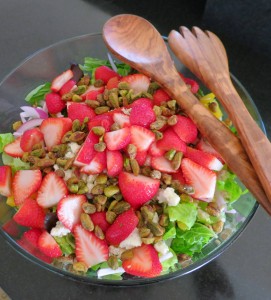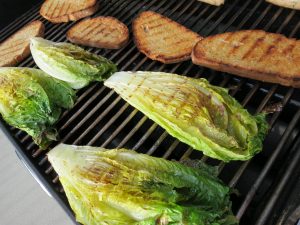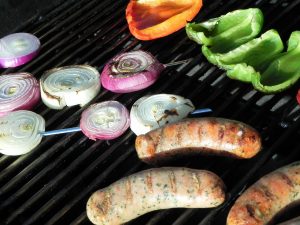June is Fresh Fruit and Vegetable Month, the perfect time to lock in habits that include a rainbow of produce.
How much is enough? You’ve heard “5 servings a day,” but recent evidence shows that doubling it to 10 servings has even greater benefits, well summarized on fruitandveggiesmorematters.org (2).
In a nutshell, the largest study of fruit and vegetable consumption (3) showed significantly lower risk of premature death and of chronic diseases such as heart disease, stroke and cancer, with 10 produce servings (800 grams) daily (7 to 7.5 or 600 grams for reduced cancer risk).
These amounts seem daunting considering that 87% of Americans fall short of vegetable recommendations and 75% don’t meet fruit recommendations (1). However, while 10 servings offered the most benefit, smaller amounts, even 2.5 servings per day, offer risk reduction benefits, too.
There are many ways to boost produce intake. Given America’s love affair with outdoor cooking (Seventy-five percent of Americans own a grill.), and the fact that it’s peak grilling season, I suggest making room on the grill for vegetables and fruits. The barbecue or grill is a space where meat dominates: burgers are the most popular, but other favorites are chicken, hot dogs and steak (4,5).
Here are benefits of including produce in your outdoor cooking:
*Grilling is easy and it’s fun to get outside and cook
*Like oven-roasting, grilling concentrates flavors and caramelizes the natural sugars for great taste
*Chemicals that may increase cancer risk don’t occur when grilling produce (6)
Grilled fruit can be a side or dessert and grilled vegetables can take center stage on the plate. For inspiration and how-to guides, see references 7-11.
Healthy Grilling with Beef (12) shows how meat and vegetables can share the grill and team up for an easy, tasty meal, Grilled Steak & Vegetable Salad. Plus, it discusses how to grill beef to reduce the formation of heterocyclic amines (HCAs) and polycyclic aromatic hydrocarbons (PAHs), the compounds that have been linked to cancer in animal research. It’s important to note that the doses of HCAs and PAHs used in the studies were very high – thousands of times greater than what one would normally consume (13).
HCAs are formed when the amino acids, sugars and creatine in muscle meat ( poultry, fish and red meat) are cooked at high temperatures. PAHs form when the fat and juices drip onto the fire, causing flames and smoke.
Ways to reduce PAH and HCA formation when grilling meat, chicken and even fish include (13,14,15,16):
- Trim fat from meat before grilling so it doesn’t drip down and cause flare-ups and smoke.
- Marinate the meat in a marinade with no or little added sugar and vinegar, citrus juice or beer for at least 30 minutes. Include antioxidant herbs and spices such as garlic, rosemary, thyme, ginger, red chili peppers and thyme.
- Use smaller cuts or put cubed meat on kebabs or precook the meat in a microwave oven before grilling to shorten contact with high heat.
- Grill at lower temperatures, turn the meat frequently and don’t overcook it. (You want to avoid high heat and charring. Remove any charred portions and discard.)
Meat portion guidelines from the American Cancer Institute include serving processed meats like hot dogs on special occasions and consuming under 18 ounces of cooked red meat each week. That’s a very reasonable 3 (4-ounce) servings a week.
With safe grilling practices, you don’t have to give up the pleasure of cooked meats. Be mindful of portion sizes and focus on filling your plate with the season’s best fresh produce.
References
- Percentage of Youth Meeting Federal Fruit and Vegetable Intake Recommendations, Youth Risk Behavior Surveillance System, United States and 33 States, 2013. Latetia V Moore, PHD, E. Thompson, PhD, Zewditu Demissie, PhD. J Acad of Nutr Diet 2017; 117:4) 545-553.
- About the Buzz: Eat 10 Servings of Fruits and Vegetables Per Day ?http://www.fruitsandveggiesmorematters.org/eat-10-servings-of-fruits-and-vegetables-per-day/
- Fruit and vegetable intake and the risk of cardiovascular disease, total cancer and all-cause mortality–a systematic review and dose-response meta-analysis of prospective studies.https://academic.oup.com/ije/article/doi/10.1093/ije/dyw319/3039477/Fruit-and-vegetable-intake-and-the-risk-of
- The United States of Barbecue – America’s Love Affair with Backyard Cooking. By Larry Olmsted. Forbes. April 28, 2016. https://www.forbes.com/sites/larryolmsted/2016/04/28/the-united-states-of-barbecue-americas-love-affair-with-backyard-cooking/#7ef9bf225a1d
- 11 Facts to Raise Your Grilling IQ, by Amy Roberts, CNN, June 14, 2016 http://www.cnn.com/2013/06/21/living/grilling-by-the-numbers/index.html
- Chemicals in Meat Cooked at High Temperatures and Cancer Risk http://www.cancer.gov/cancertopics/factsheet/Risk/cooked-meats
- Summer’s Secret Ingredient: Grilled Vegetables by Susie Middleton, Fine Cooking Issue 51. http://www.finecooking.com/article/summers-secret-ingredient-grilled-vegetables
- 21 Ways to Grill Fruits and Veggies, Vegetarian Times. https://www.vegetariantimes.com/skills/20-ways-to-grill-fruits-amp-veggies
- All About Grilling Fruit. Sodium Girl, July 1, 2014. Food52.com https://food52.com/blog/10721-all-about-grilling-fruit
- Cooking Light’s Grilled Fruits and Veggies, Cooking Light. http://www.cookinglight.com/entertaining/menus-for-entertaining/grilled-fruits-vegetables-recipes
- 5 Tips for How to Cook Grilled Vegetables Perfectly. Eating Well. http://www.eatingwell.com/healthy_cooking/healthy_cooking_101_basics_techniques/5_tips_for_how_to_cook_grilled_vegetables
- Healthy Grilling with Beef, Grilled Steak and Vegetable Salad https://p.widencdn.net/8hfcbk/09-18521-GrillingFactSheet-Final
- The National Cancer Institute – Chemicals in Meat Cooked at High Temperature and Cancer Risk https://www.cancer.gov/about-cancer/causes-prevention/risk/diet/cooked-meats-fact-sheet
- American Institute for Cancer Research: How to Grill to Lower Cancer Risk http://www.aicr.org/enews/2017/05-may/enews-how-to-grill-for-lower-cancer-risk.html
- Minnesota Oncology. From the Dietitian: Guidelines for Grilling, April 3, 2015 by Sarah Barts, RD, LD
http://mnoncology.com/about-us/practice-news/from-the-dietitian-guidelines-for-grilling/
- Oxidative Stress Markers and inflammation: The Role of Spices and Herbs By Heber, David MD, PhDhttp://www.mccormickscienceinstitute.com/resources/msi-summit/summit-proceedings/oxidative-stress-markers-and-inflammation-the-role-of-spices-and-herbs
© Lorelle Del Matto 2017





 About lorelle
About lorelle
[…] salad can make consuming 10 (or at least 5) servings of produce every day easy. See my post for Fresh Fruit and Vegetable Month , for more on the health benefits of a produce-rich eating […]